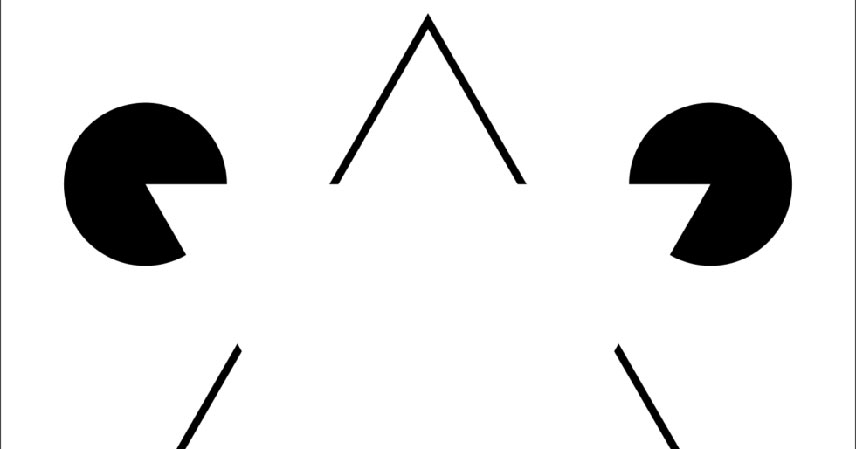Our world is often not as it seems. Visual illusions frequently challenge our perception. They offer a fascinating glimpse into how our brains construct reality. A groundbreaking new study sheds light on this intricate process. It identifies specific neurons responsible for these compelling visual tricks.
Hyeyoung Shin, assistant professor of neuroscience at Seoul National University, perfectly captures this phenomenon. She states, “Illusions are fun, but they are also a gateway to perception.” This insight underpins a significant discovery. It promises to deepen our understanding of visual processing.
Seeing What Isn’t There: The Power of Perception 🧠
Illusory contours are a prime example of the brain’s creative power. These are edges that we clearly perceive. However, they do not physically exist in the visual input. Our minds actively fill in the gaps. This creates a coherent, albeit fabricated, image.
The classic Kanizsa triangle vividly demonstrates this. Three ‘Pac-Man’ shapes are arranged in a specific way. Our brain then perceives a bright white triangle. This triangle appears to float above the background. It has distinct, sharp borders. Yet, these borders are entirely absent from the actual image.
If you cover the ‘Pac-Man’ shapes, the illusion vanishes. The uniform background reappears. This simple act reveals the trick. It highlights our brain’s active role in constructing visual experience. For over two decades, neuroscientists have explored this phenomenon. Studies in primates, humans, and mice have shown neural responses. Neurons in the primary visual cortex (V1) and higher visual areas respond to both real and illusory contours. This established a neurological basis for such perceptions.
The Breakthrough: Unmasking IC-Encoders 🔍
The new study, published in Nature Neuroscience, marks a significant leap forward. It moves beyond simply observing neural responses. The research, led by Hyeyoung Shin, identified a specific population of neurons. These neurons are located within the visual cortex. They have been dubbed IC-encoders.
Crucially, the study shows their direct role. IC-encoders are not just responding to illusions. They are actively representing them. This is a key distinction. It suggests a dedicated neural mechanism. This mechanism is responsible for constructing these illusory perceptions. This detailed identification provides unprecedented clarity. It offers a tangible neural substrate for a complex cognitive process.
The work is a testament to collaborative science. It involved researchers from the University of California, Berkeley. The Allen Institute in Seattle also contributed. Seoul National University played a central role. This multi-institutional effort underscores the complexity. It also highlights the interdisciplinary nature of modern neuroscience research. Their combined expertise was essential. It allowed for such a precise and impactful discovery.
Why This Matters: Implications for Understanding the Brain and Beyond 💡
This discovery has profound implications. It touches upon our fundamental understanding of perception. Our brains are not passive receivers of information. Instead, they are active interpreters. They constantly make inferences. They fill in missing data. This study offers a concrete example of this constructive process. It shows how the brain actively ‘knows’ what isn’t physically present.
Understanding IC-encoders could unlock secrets. It could reveal how the brain creates our subjective reality. This goes beyond simple vision. It impacts how we interpret complex scenes. It influences how we recognize objects. It even affects how we navigate our environment. The brain often predicts what it expects to see. It then uses minimal cues to confirm these predictions. Illusions exploit this predictive power.
Furthermore, this research could inform artificial intelligence. Current AI models often struggle with human-like perception. They excel at pattern recognition. Yet, they lack the nuanced inferential capabilities of the human brain. Learning how our brains construct illusory contours could inspire new AI architectures. These could allow machines to ‘perceive’ more effectively. They could make more human-like judgments from incomplete data. This could revolutionize fields like computer vision and robotics.
The study also opens new avenues for clinical research. Altered perception is a symptom of various neurological conditions. Understanding the healthy mechanisms behind perception is vital. It provides a baseline. It helps identify what goes wrong in conditions like schizophrenia or certain visual processing disorders. Future research might explore if IC-encoder dysfunction plays a role in these conditions. This could lead to novel diagnostic tools or therapeutic strategies.
Key Insights: Decoding Our Visual World ✨
- A specific population of neurons, named IC-encoders, has been identified in the visual cortex.
- These IC-encoders play a direct and active role in representing visual illusions, such as the Kanizsa triangle.
- The discovery deepens our understanding of how the brain constructs perception, actively filling in missing visual information.
- This research has potential implications for advancing artificial intelligence, enabling more human-like perceptual capabilities in machines.
- The study was a collaborative effort. It involved leading institutions in neuroscience research.
The identification of IC-encoders is more than just a scientific curiosity. It offers a tangible piece of the puzzle. It explains how our brains create the rich, complex world we experience. Even when that world is, in part, an illusion. This research reminds us of the brain’s incredible capacity. It highlights its constant, subtle artistry in shaping our reality.
Source: The neurons that let us see what isn’t there



